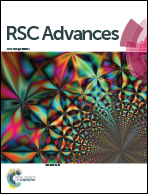Rigid three-dimensional Ni3S4 nanosheet frames: controlled synthesis and their enhanced electrochemical performance†
Abstract
Rigid three-dimensional (3D) Ni3S4 nanosheet frames assembled from ultrathin nanosheets are synthesized via a facile solvothermal method. Compared to flat Ni3S4 sheets, 3D Ni3S4 nanosheet frames have both a high free volume and high compressive strength. They can deliver a very high specific capacitance of 1213 F g−1 with good rate performance. In addition, these 3D Ni3S4 nanosheet frames are stabilized by plastically deformed ridges. The stabilized nanosheet frames did not unfold or collapse during electrochemical tests, and thus showed enhanced cycling ability.


 Please wait while we load your content...
Please wait while we load your content...